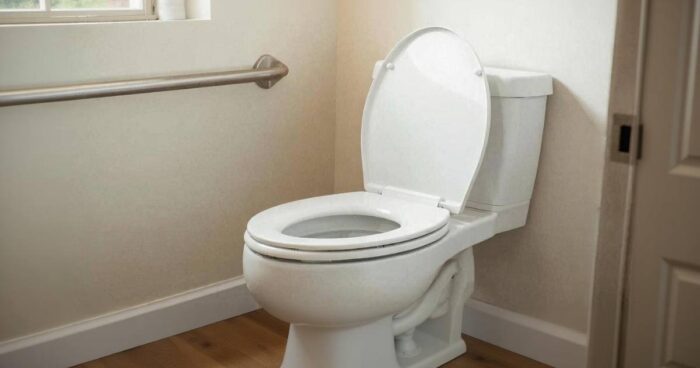The bathroom, a place of essential daily routine, can ironically be one of the most dangerous rooms in the house for an elderly loved one. The simple, private act of using the toilet is often where fears of slips and falls become a terrifying reality.
As a caregiver, this can be a constant source of anxiety, knowing that a moment of independence could lead to a serious injury. However, with the right strategies and tools, you can transform this vulnerable space into a safer, more secure environment.

Let’s explore practical safety tips that protect your loved one’s dignity and well-being every time they use the restroom.
Even if an older adult is independent, they may still need a little help when using the bathroom.
It’s easy for seniors to fall when walking to the bathroom in a rush or when sitting or standing from the toilet due to blood pressure changes.
Safety First When Lifting Aging Adults Around the Home
Because family caregivers don’t get formal training in safe lifting and transfer techniques, it’s too easy to hurt yourself when you’re helping your older adult.
These safety tips help you support your older adult using the toilet and reduce the risk of injury.
Basic Safety Tips for Toileting an Aging Adult
- Please encourage them to move on their own as much as possible to reduce the chance of injury for both of you. You’re mostly there for balance support.
- Never lift your senior outright or ask them to pull on you. This is likely to cause injury to one or both of you.
- Hold on to their trunk and hips to keep them stable. Don’t pull their arms or legs, that could injure fragile extremities or throw them off-balance.
- Always bend your knees when supporting them as they lower or raise themselves. If you bend at the waist, you risk injuring your back.
Clear Communication is Essential
Before moving, use short sentences to explain the next step so an older adult knows what to expect. And give them plenty of time to do what you ask.
Examples:
- The toilet seat is right behind you. Squat down slowly to sit.
- I’m going to help you stand up now. Scoot your butt forward.
- Lean forward and put your hands on my forearms when you’re ready.
Getting to the Bathroom Safely
- Allow an older adult to walk at their own pace, but stay close and be ready in case they wobble or trip.
- Once they’re near the toilet, ask them to turn slowly in small steps until the bathroom is directly behind them.
Pro tip: Getting to the bathroom safely can take some time. To reduce the risk of an accident if getting to the toilet takes longer than expected, make regular trips to the bathroom to minimize urgency—try after meals and every couple of hours.
Toilet Tips: How to Sit and Stand Safely
- Ask an older adult to lower themselves slowly onto the toilet seat while holding onto your forearms. Steady them with your hands on their trunk. Bend your knees as they lower themselves.
- Before standing up, ask them to scoot forward a little and place their hands on your forearms before slowly raising themselves. Please keep your hands on their trunk and bend your knees.
- Don’t let them hold on to their walker while sitting or standing, as it could tip over and cause a fall.
Example:
This image gives you an idea of the positioning and sitting technique when using a walker and a toilet seat with arms. But instead of the pictured foot position, keep both feet firmly on the floor and sit using a squatting motion. Your older adult will be steadier, stronger, and more balanced than the woman in this picture.
Final Thoughts
Implementing even one or two of these safety tips can dramatically reduce the risk of a life-altering fall and provide priceless peace of mind for everyone involved. Remember, creating a safer bathroom isn’t about restricting your loved one’s independence, it’s about empowering them to maintain their privacy and routine with greater confidence and security.
This is a proactive step that says, “Your safety matters.” So take a look around the bathroom today; a few small changes can make all the difference in preserving your loved one’s health and your own sense of calm.
Recommended for you:
— 4 Simple Bathroom Safety Tips for Seniors
— Help Your Older Adult Move from Wheelchair to Toilet
— Home Safety for Seniors: 10 Quick Fixes for Bathroom, Bedroom, and Kitchen
About the Author

Connie is the founder of DailyCaring.com and was a hands-on caregiver for her grandmother for 20 years. (Grandma made it to 101 years old!) She knows how challenging, overwhelming, and all-consuming caring for an older adult can be. She also understands the importance of support, especially in the form of practical solutions, valuable resources, and self-care tips.













As a patient, I have had handrails installed on my toilet which are a great help to me.
Check with your plumber.
thank you for sharing Vic! They really do help a great deal.